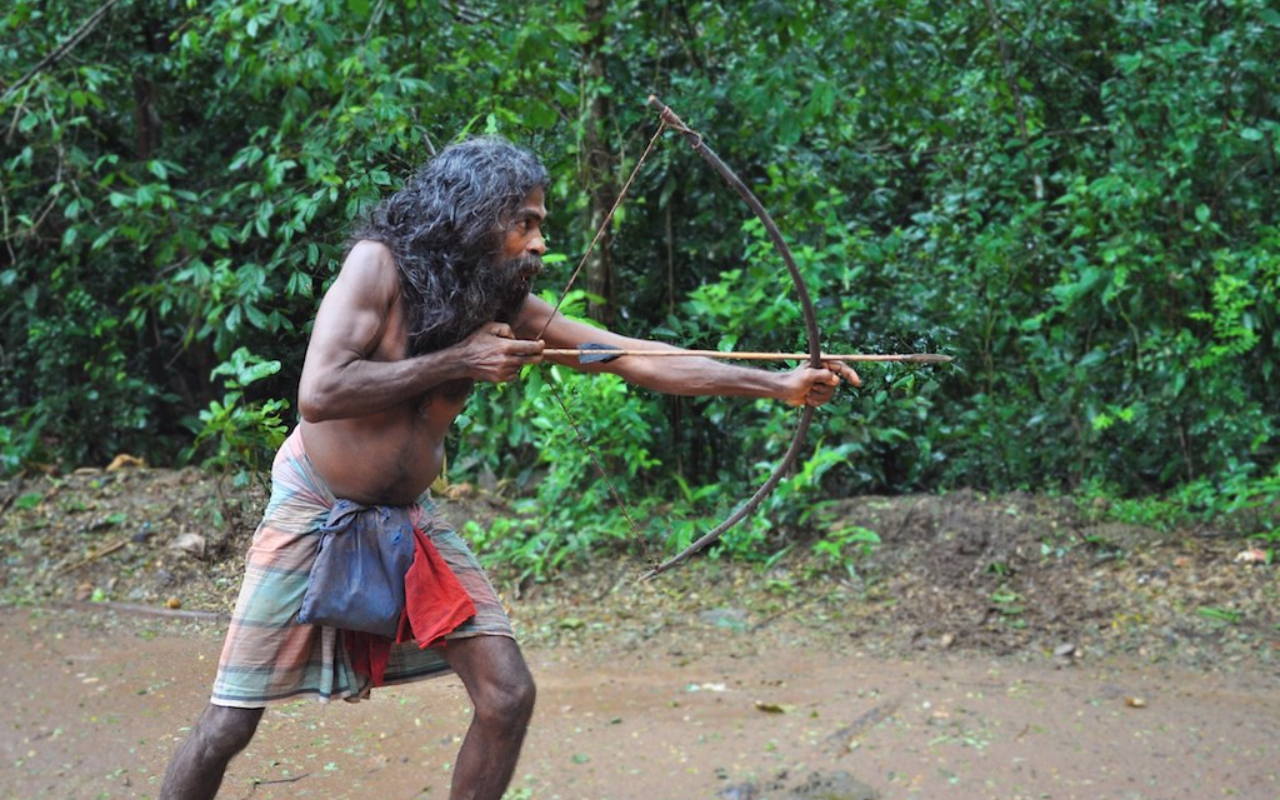Tucked away in the emerald folds of Sri Lanka’s hilly Uva Province are Bintenna and Dambana, living repositories of a sustainable lifestyle shaped by deep ecological awareness and Indigenous wisdom. These regions are home to Sri Lanka’s Indigenous people, or the Vedda people, whose traditions, values, and daily practices reflect an intimate bond with nature. Among these lush landscapes, the Vedda communities live in harmony with the wild, guardians of traditions passed down through generations.
If you’re looking to go beyond the beaches, ancient ruins and tea plantations of Sri Lanka, a visit to Dambana and the Bintenna region offers a rare and meaningful experience – one that connects you with the country’s earliest inhabitants and a way of life deeply rooted in nature, tradition and sustainability. Let’s take a deeper look.
Where is Dambana and Bintenna?
Dambana is a remote village in the Badulla District of Uva Province, in the southeastern part of Sri Lanka. It lies near the Mahiyanganaya area, close to the Maduru Oya National Park, which is rich in biodiversity and forest cover.
Bintenna refers to a larger historical and geographical region that spans parts of Uva and Eastern Provinces, including areas near Mahiyanganaya, Rideemaliyadda, and parts of Ampara District. Historically, it was a dense, forested area and part of the traditional lands of the Vedda people. Today, Bintenna includes rural villages and forested zones between the central highlands and the eastern plains, along the Mahaweli River, Sri Lanka’s longest river.
Witness a Truly Sustainable Way of Life
In a world impacted by climate change and overconsumption, the Vedda way of life offers powerful lessons in ecological wisdom. Their practices, like selective gathering, rotational farming and low-impact living, demonstrate how communities can live in harmony with the environment without exploiting it. Visiting Dambana and Bintenna isn’t just sightseeing – it’s a masterclass in practical sustainability.
What you will see;
Traditional Practices and Resource Use
The Vedda people live in harmony with nature, harvesting what they can from natural environments and engaging in sustainable agriculture. They have long practised rotational slash-and-burn (chena) cultivation, a farming method that allows forest land to regenerate naturally. This form of agriculture is low-impact, avoids synthetic chemicals and relies on local biodiversity. They harvest honey, herbs, fruits and yams from the forest, taking only what they need and leaving the rest to the natural world, enabling other species to survive and thrive.
Once a primary food source, hunting with bows and arrows is still practised to a certain extent. With today’s legal restrictions, many Vedda communities have shifted toward agriculture and eco-tourism while trying to retain their ecological ethos.
In Vedda villages, clay, thatch and wood are often used to build homes. These materials come from renewable sources, blend into the environment and require little energy to source or maintain.
Cultural and Spiritual Connection to Nature
Nature is more than a resource for the Vedda people – it is sacred to them. Many natural sites, such as forests, caves and rivers, are tied to spiritual beliefs and ancestral worship. Forests are considered the dwelling places of spirits, and rituals honour ancestors and natural deities.
The annual Kiri Koraha ritual, a dance to invoke blessings and healing from ancestral spirits, is one example of this spiritual bond with the natural world. Songs, chants and storytelling are intrinsic to their cultural and spiritual practices.
Why You Should Visit Vedda Villages and Communities?
Authentic Cultural Encounters
The Vedda community of Dambana is one of the few remaining Indigenous groups in South Asia still practising aspects of their ancestral lifestyle. Visiting their villages provides a unique opportunity to:
- Witness traditional customs, such as storytelling, hunting rituals and ancient songs.
- Learn about sustainable forest-based living and respect for the land.
- Understand their deep spiritual connection to nature and ancestral spirits.
Blue Lanka Tours handpicks visits grounded in cultural integrity and respectful engagement.
Unspoiled Nature and Biodiversity
The region is a gateway to some of Sri Lanka’s least disturbed ecosystems. Located near Maduru Oya National Park, Dambana offers wildlife encounters, birdwatching, and forest treks through lush jungles and riverine landscapes. To the east of the island, in the Ampara region, you will find Vedda communities in and around Gal Oya National Park, another remote, less crowded and beautiful natural environment, famous for its swimming elephants.
You will also spot numerous wildlife, medicinal herbs, exotic fruits and endemic plant species while walking alongside Vedda guides who know the forest like the back of their hand.
Support for Indigenous Communities through Responsible Tourism
By visiting the Vedda villages with ethical tour operators or local guides, you contribute directly to community-led initiatives that preserve traditions and support livelihoods. Responsible tourism helps preserve cultural practices by empowering those who practice them. They will not have to forego tradition for regular work as a livelihood.
Traversing the Remote Sri Lanka with Luxury
Visiting the Vedda villages of Dambana and Bintenna offers a glimpse into Sri Lanka’s oldest culture, a chance to reconnect with our shared human relationship with nature and a way to travel consciously in an increasingly fast-paced world. It is enriching, humbling and unforgettable. The forest will welcome you, and the people will share stories that no guidebook can offer.
Blue Lanka Tours travels into the most remote corners of Sri Lanka with travellers seeking off-the-beaten-track adventures and our goodwill work, Blooming Smiles. We recognise the beauty and uniqueness of these incredible parts of the island and incorporate them in our travel experiences.
As a responsible tour company, we only curate travel to indigenous communities with the highest regard for their culture, privacy and habitats. Our goal is to enable the direct benefits of tourism on these communities. Blue Lanka Tours also highlights the less-explored national parks on the island, which are exceptional, singular and better for wildlife wellbeing. What are you looking for in the hottest tropical destination in Asia? Let us know and we will tailor-make it for you.

